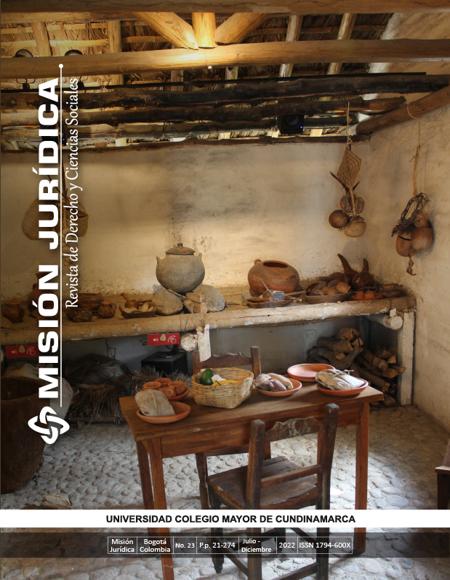The Law of may 21, 1851 on the freedom of slaves : a legislative and legal injustice
La Ley del 21 de mayo de 1851 sobre la libertad de esclavos : una injusticia legislativa y jurídica
COPYRIGHT PROVISIONS
Every papper included in the magazine can be reproduced whole or in part, provided that respect for its original content, the source is acknowledged and is used with non-commercial academic. Legal mission and its content is protected under a license Creative Commons Attribution-Noncommercial-

Misión Jurídica is distributed under a Creative Commons Attribution-NonCommercial-NoDerivar 4.0 International License.
Based on a work in http://unicolmayor.edu.co/publicaciones/index.php/mjuridica/index.
Permits that go beyond what is covered by this license can be found at http://unicolmayor.edu.co/publicaciones/index.php/mjuridica/index.
Show authors biography
It is intended to demonstrate that the origin of racial discrimination, poverty and social exclusion of the Afro-Colombian people dates back to the Law of May 21, 1851, and that such situation persists due to the indifference of the State. This has determined the wide socio-economic inequality gap that exists between the Afro-Colombian people and the rest of the population. For this purpose, the Law of May 21, 1851, the Sentence C-931 of 2009, books, scientific articles and a course of Afro-Colombians, their history, struggles and achievements presented to Professor Kevin Parthenay form the Institute of Political Science of Paris in 2014, are reviewed. It was confirmed that the Law contains discriminations and inequalities among the parts of the servile system. Thus, since colonial times and the beginning of the Republic the Afro-descendants have been excluded from society, victims of racism and -currently- of the State’s indifference. In this respect, the Constitutional’s Court inhibitory sentence was criticized because there were elements that allowed for a substantial pronouncement.
Article visits 198 | PDF visits 393
Downloads
- Almario G., O. (2005). "Etnias, regiones y Estado nacional en Colombia Resistencia y etnogénesis en el Gran Cauca". Relatos de Nación: La construcción de las identidades nacionales en el mundo hispánico. F. Colom G., Frankfurt A. M., Vervuert Verlagsgesellschaft, pp. 801-820. https://doi.org/10.31819/9783964565501-035
- Capdevila, N. (2011). Las Casas et les Noirs: quels problèmes? Presses universitaires de Perpignan.
- Castro H., I., y Sala-Molins, L. (2002). Déraison, esclavage et droit: les fondements idéologiques et juridiques de la traite négrière et de l'esclavage. UNESCO.
- CIDH. (2010). Informe anual de la Comisión Interamericana de Derechos Humanos 2009.
- Confernencia de Durbán (2001). Conferencia Mundial contra el Racismo, la Discriminación Racial, la Xenofobia y las Formas Conexas de Intolerancia. https://www.acnur.org/fileadmin/Documentos/BDL/2002/1285.pdf?file=fileadmin/Documentos/BDL/2002/1285
- Escobar, P., C. A. (3 de abril, 2018). Belén de Bajirá, entre Antioquia y Chocó. Semana.
- García H., A. (2018). José Hilario López, el libertador de los esclavos. Prospectiva en justicia y desarrollo. https://projusticiaydesarrollo.com/2018/02/18/jose-hilario-lopez-el-libertador-de-los-esclavos/
- La Biblia
- Lucena S., M. (2000). Los códigos negros de la América española. Universidad Alcalá de Henares.
- Maturana, O. (2011). Afrodescendientes en la independencia. Libros en Red.
- Milton, J. R (1997). John Locke and the Fundamental Constitutions of Carolina. En Locke, ed. J. Dunn y I. M. Harris, Lyme, USA: Edward Elgar Publ., pp. : 463-485
- Mosquera R.-L., C. P., y Barcelos, L. C. (Edits.). (2007). Afro-reparaciones: Memorias de la Esclavitud y Justicia Reparativa para negros, afrocolombianos y raizales. Universidad Nacional de Colombia/Observatorio del Caribe Colombiano.
- ONU (2002). Informes de la Organización de las Naciones Unidas sobre DDHH y DIH en Colombia 1980-2002. https://www.hchr.org.co/informes_tematicos/informes-de-la-organizacion-de-las-naciones-unidas-sobre-ddhh-y-dih-en-colombia-1980-2002/
- Ortiz, F. (1994). Los tambores ñáñigos. Letras cubanas.
- Perea-Grandin, L. (2003). La realidad cultural afrocolombiana. Présence Africaine (N° 167-168), pp. 218 – 233.
- Programa de las Naciones Unidas para el Desarrollo (PNUD) (2012). Los Afrocolombianos frente a los objetivos de desarrollo del milenio. https://blog.utp.edu.co/etnopediatria/files/2015/03/informe_afrocolombianos_resumen.pdf
- Rivas, S. (Director). (2022, 11 de abril). Muertos invisibles en el Putumayo. El lunes. Mesa Capital. https://www.youtube.com/watch?v=mvjRnCWXuJI
- Sala-Molins, L. (2018). Le code noir ou le calvaire de Cannaan. PUF.
- Tardieu. (1985). Le destin des Noirs aux Indes de Castille: XVIe-XIIe siècles. L'Marmattan
- Taubira, C. (2012). Mes météores. Combats politiques au long cours. Flammarion.
- Tovar, P. H. (1994). La manumisión de esclavos en Colombia, 1809-1851, Aspectos sociales, económicos y políticos. Credencial Historia. No. 59.
- Zapata O., M. (1989). Las claves mágicas de América: raza, clase y cultura. Universidad del Valle.















